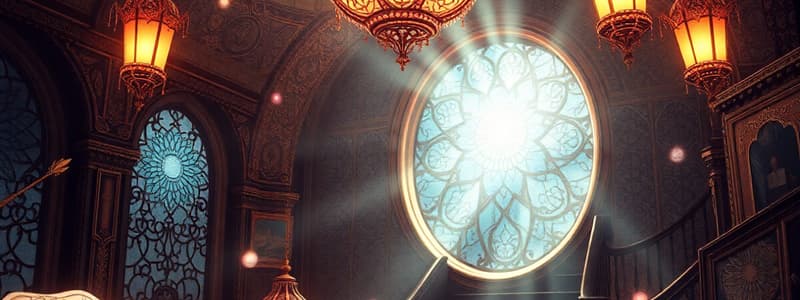Podcast
Questions and Answers
What is the angle of incidence?
What is the angle of incidence?
- The angle between the incident ray and the reflected ray
- The angle between the incident ray and the normal to the surface (correct)
- The angle between the incident ray and the surface
- The angle between the reflected ray and the surface
Which type of reflection produces clear images?
Which type of reflection produces clear images?
- Diffuse reflection
- Scattered reflection
- Specular reflection (correct)
- Irregular reflection
In which scenario does diffuse reflection occur?
In which scenario does diffuse reflection occur?
- When light strikes a rough surface (correct)
- When light passes through a lens
- When light reflects off a smooth mirror
- When light is absorbed by a surface
What does the law of reflection state?
What does the law of reflection state?
Which type of mirror can produce both real and virtual images?
Which type of mirror can produce both real and virtual images?
What is a distinguishing characteristic of convex mirrors?
What is a distinguishing characteristic of convex mirrors?
Where does the normal line in reflection point?
Where does the normal line in reflection point?
Which application relies on reflection principles for focusing images?
Which application relies on reflection principles for focusing images?
What happens to the distance of an image in plane mirrors compared to the object?
What happens to the distance of an image in plane mirrors compared to the object?
What is a characteristic of light rays during specular reflection?
What is a characteristic of light rays during specular reflection?
Flashcards
Angle of Incidence
Angle of Incidence
The angle between the incoming light ray and the line perpendicular to the surface at the point of incidence.
Angle of Reflection
Angle of Reflection
The angle between the reflected light ray and the line perpendicular to the surface at the point of incidence.
Law of Reflection
Law of Reflection
The law states that the angle of incidence is equal to the angle of reflection.
Specular Reflection
Specular Reflection
Signup and view all the flashcards
Diffuse Reflection
Diffuse Reflection
Signup and view all the flashcards
Concave Mirror
Concave Mirror
Signup and view all the flashcards
Convex Mirror
Convex Mirror
Signup and view all the flashcards
Plane Mirror
Plane Mirror
Signup and view all the flashcards
Focal Point
Focal Point
Signup and view all the flashcards
Focal Length
Focal Length
Signup and view all the flashcards
Study Notes
Reflection of Light: Basic Concepts
- Light travels in straight lines, called rays.
- Reflection occurs when a light ray strikes a surface and bounces off.
- The angle of incidence is the angle between the incident ray and the normal to the surface.
- The angle of reflection is the angle between the reflected ray and the normal.
- The law of reflection states that the angle of incidence is equal to the angle of reflection.
- The normal is an imaginary line perpendicular to the surface at the point of incidence.
- Reflection can be specular or diffuse.
- Specular reflection occurs when a light source reflects off a smooth surface, creating a clear image.
- Diffuse reflection occurs when a light source reflects off an uneven surface, scattering the light in different directions.
Types of Reflection
- Specular Reflection
- Occurs on smooth surfaces like mirrors.
- The reflected rays are parallel to each other if the incident rays are parallel.
- Forms clear images of objects.
- Diffuse Reflection
- Occurs on rough surfaces like paper or a wall.
- Reflected rays are scattered in many directions.
- Enables us to see objects from different angles.
- Gives us the perception of the color of objects.
Laws of Reflection
- The incident ray, the reflected ray, and the normal all lie in the same plane.
- The angle of incidence is equal to the angle of reflection.
- This is a fundamental concept in optics, allowing for the prediction and explanation of how light behaves when interacting with surfaces.
Image Formation by Mirrors
- Mirrors create images of objects.
- The position, size, and nature of the image depend on the type of mirror (concave or convex) and the object's position relative to the mirror.
- Concave Mirrors
- Converging mirrors
- Can produce real or virtual images, depending on the object's position.
- Convex Mirrors
- Diverging mirrors
- Always produce virtual, upright, and diminished images.
- Plane Mirrors
- Produce virtual, upright, and the same size images as the object.
- The image is the same distance behind the mirror as the object is in front of it.
Applications of Reflection
- Mirrors: Used in various applications like telescopes, periscopes, and cars.
- Optical Instruments: Telescopes, microscopes, and cameras rely on the principles of reflection to magnify and focus images.
- Lasers: Reflecting mirrors are crucial in laser cavities to maintain and control the laser beam.
- Building Design: Architectural designs use reflective surfaces to redirect/manage natural light sources, like focusing sunlight.
Reflection from Curved Surfaces
- Curved mirrors (either concave or convex) focus or diverge light rays.
- Concave mirrors can be used to focus light rays to a point, which can be used to concentrate the heat or to produce a real image.
- Convex mirrors diverge light rays, which can be used to provide a wider field of view—for example, in side-view mirrors on cars.
Real vs. Virtual Images
- Real images are formed where light rays actually converge.
- Virtual images are formed where light rays appear to converge.
- Real images can be projected onto a screen, whereas virtual images cannot.
Studying That Suits You
Use AI to generate personalized quizzes and flashcards to suit your learning preferences.
Description
Explore the fundamental principles of light reflection in this quiz. Learn about the angles of incidence and reflection, the role of the normal line, and the difference between specular and diffuse reflection. Perfect for students looking to solidify their understanding of light behavior.




